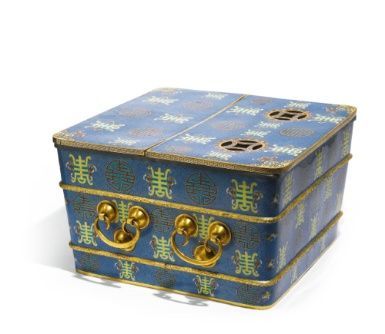A Rare Underglaze-Blue Polychrome-Enamelled 'Magpie and Prunus' Moonflask, Qianlong Seal Mark and Period - Photo Sotheby's
the flattened globular body rising from a short oval foot to a waisted neck flanked by a pair of ruyi handles, delicately painted in underglaze-blue and enamelled in shades of green, yellow, iron-red, pink and white, each face depicting a bird perched on a gnarled branch of prunus blossom accompanied by bamboo, all between pendent and upright hooked flame motifs, the neck decorated with further bamboo branches, inscribed to the base with a six-character Qianlong seal mark in underglaze blue; 28.5cm., 11 1/4 in. Estimation: 300,000 - 500,000 GBP
PROVENANCE: An English Private Collection, acquired in the 1970s
NOTE DE CATALOGUE: The present flask appears to be unique, but in form and design it pays homage to a blue-and-white prototype of the celebrated Yongle reign (1403-24) in the Ming dynasty. Although at present only one Yongle example still appears to be extant, the design proved popular at the Qing imperial kilns and was copied both in the Yongzheng (1723-35) and Qianlong (1736-95) periods, in underglaze blue as well as in underglaze red. The polychrome rendition of the design on the present flask, however, is highly unusual and no comparable example appears to be recorded.
Famille rose, or fencai, decoration incorporating any underglaze cobalt-blue in the overall colour scheme is exceedingly rare, and on the present flask under- and overglaze colours are admirably entwined to form a harmonious picture. Equally rare is the outline-free rendering of the scrollwork around shoulder, handles and foot of this flask.
The complicated ‘assemblage’ of a design such as this, where disconnected underglaze-blue features were painted on their own onto the raw white porcelain body before glazing and firing, and the polychrome enamels were only afterwards added in to complete the polychrome image, are otherwise known almost only from the complex wucai palette of the Ming dynasty. In the Qing dynasty, potters almost invariably omitted the use of underglaze blue in polychrome patterns, working exclusively with overglaze enamels – a procedure that immensely simplified the task and minimized the failure rate.
Other rare examples executed in this famille rose style that incorporates underglaze blue are a small globular jar decorated with boys at play, where particularly some of the rocks in the background are painted in underglaze blue, and a vase with a design of a hundred monkeys, also with details in underglaze blue, both of Qianlong mark and period, in the Palace Museum, Beijing, illustrated in Kangxi, Yongzheng, Qianlong. Qing Porcelain from the Palace Museum Collection, Hong Kong, 1989, p.341, pl. 22, and p. 346, pl. 27; and a vase with a famille rose dragonand-phoenix design in the National Palace Museum, Taipei, where stems and leaves of the surrounding peony scroll were executed in cobalt-blue; see Qing Kang Yong Qian ming ci tezhan/Catalog of the Special Exhibition of K’ang-hsi, Yung-cheng and Ch’ien-lung Porcelain Ware from the Ch’ing Dynasty in the National Museum Palace (sic), National Palace Museum, Taipei, 1986, cat. no. 84.
Otherwise the combination of famille rose enamels with underglaze cobalt-blue is occasionally seen on pieces where an enamel design is either outlined in blue, as in the doucai style, or bordered by blue bands, both being styles that do not necessitate precise advance planning to ensure successful interweaving of under- and overglaze colours. For the former see a bowl illustrated in Regina Krahl, Chinese Ceramics from the Meiyintang Collection, London, 1994-2010, vol. 4, no. 1749, sold in our Hong Kong rooms 7th April 2011, lot 7; for the latter a pair of meiping in the Baur collection with famille rose magpies on flowering and fruiting branches between underglaze-blue borders on neck, shoulder and foot, illustrated in John Ayers, Chinese Ceramics in the Baur Collection, Geneva, 1999, vol. 2, pls 232 and 233.
While the blue-and-white prototypes of this design, of both Ming and Qing dynasties, show two different scenes on the two sides, but are unmarked, the copper-red version of the Qianlong period is very close to the present piece, and has the same scene painted on both sides. The Yongle prototype, presently in the British Museum from the Sir Percival David Collection, London, is illustrated, for example, in Regina Krahl and Jessica Harrison-Hall, Chinese Ceramics. Highlights of the Sir Percival David Collection, London, 2009, p. 61; an unmarked blue-and-white flask attributed to the Yongzheng period, from the Richard de la Mare, Su Lin An, and Meiyintang collections, is illustrated in Krahl, op.cit., no. 1712, and was sold in our Hong Kong rooms, 7th April 2011, lot 76; and an underglaze-red example which shows a different interpretation of the same motif, much closer to the present flask, is in the Palace Museum, Beijing, from the Qing court collection, illustrated in The Complete Collection of Treasures of the Palace Museum. Blue and White Porcelain with Underglazed Red, Shanghai, 2000, vol. III, pl. 177 (fig. 4); although no mark is mentioned for that piece, a very similar flask of Qianlong mark and period was sold in these rooms, 8th/9th July 1974, lot 279.
Sotheby's. Treasures of the Qing Court, A Personal Perspective. London | 07 nov. 2012, www.sothebys.com























 30,000 - 50,000 GBP
30,000 - 50,000 GBP



























